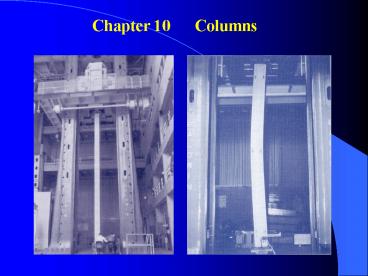Chapter 10 Columns PowerPoint PPT Presentation
1 / 35
Title: Chapter 10 Columns
1
Chapter 10 Columns
2
10.1 Introduction
Column vertical prismatic members subjected
to compressive forces
- Goals of this chapter
- Study the stability of elastic columns
- Determine the critical load Pcr
- The effective length
- Secant formula
3
Previous chapters -- concerning about
(1) the strength and (2) excessive
deformation (e.g. yielding)
This chapter -- concerning about (1)
stability of the structure (e.g. bucking)
4
10.2 Stability of Structures
Concerns before
Stable? Unstable?
New concern
(10.1)
(10.2)
5
Since
(10.2)
The system is stable, if The system is unstable
if
A new equilibrium state may be established
6
The new equilibrium position is
(10.3)
or
7
After the load P is applied, there are three
possibilities
1. P lt Pcr equilibrium ? 0 -- stable
2. P gt Pcr equilibrium ? ? -- stable
3. P gt Pcr unstable the structure collapses,
? 90o
8
10.3 Eulers Formula for Pin-Ended Columns
Determination of Pcr for the configuration in
Fig. 10.1 ceases to be stable
Assume it is a beam subjected to bending moment
(10.4)
(10.5)
9
Defining
(10.6)
(10.7)
The general solution to this harmonic function is
(10.8)
B.C.s
_at_ x 0, y 0 ? B 0 _at_ x L, y 0
Eq. (10.8) reduces to
(10.9)
10
(10.9)
Therefore,
1. A 0 ? y 0 ? the column is straight!
2. sin pL 0 ? pL n? ? p n? /L ?
(10.6)
Since
We have
(10.10)
For n 1
-- Eulers formula
(10.11)
11
Substituting Eq. (10.11) into Eq. (10.6),
(10.11)
(10.6)
Therefore,
Hence
Equation (10.8) becomes
(10.12)
This is the elastic curve after the beam is
buckled.
12
(10.9)
1. A 0 ? y 0 ? the column is straight!
2. sin pL 0 ? pL n? ?
If P lt Pcr ? sin pL ? 0
Hence, A 0 and y 0 ? straight configuration
13
Critical Stress
Introducing
Where r radius of gyration
Where r radius of gyration
(10.13)
L/r Slenderness ratio
14
10.4 Extension of Eulers Formula to columns with
Other End Conditions
Case A One Fixed End, One Free End
(10.11')
(10.13')
Le 2L
15
Case B Both Ends Fixed
At Point C
RCx 0 Q 0 ?
Point D inflection point ? M 0 ? AD and
DC are symmetric
Hence, Le L/2
16
Case C One Fixed End, One Pinned End
M -Py - Vx
Since
Therefore,
The general solution
The particular solution
17
Substituting
into the particular solution, it follows
As a consequence, the complete solution is
(10.16)
18
(10.16)
B.C.s
_at_ x 0, y 0 ? B 0 _at_ x L, y 0 ?
(10.17)
Eq. (10.16) now takes the new form
19
Taking derivative of the question,
B.C.s
_at_ x L, dy/dx ? 0
(10.18)
(10.17)
(10.19)
20
Solving Eq. (10.19) by trial and error,
Since
Therefore,
Solving for Le
Case C
Le 0.699L ? 0.7 L
21
Summary
22
10.5 Eccentric Loading the Scant Formula
23
Secant Formula
(10.36)
If Le/r ltlt 1,
Eq. (10.36) reduces to
(10.37)
24
(No Transcript)
25
10.6 Design of Columns under a Centric Load
26
10.6 Design of Columns under a Centric Load
Assumptions in the preceding sections -- A
column is straight -- Load is applied at the
center of the column -- ? lt ?y
Reality may violate these assumptions -- use
empirical equations and rely lab data
27
Test Data
Facts 1. Long Columns obey Eulers
Equation 2. Short Columns dominated by ?y
3. Intermediate Columns mixed behavior
28
Empirical Formulas
29
Real Case Design using Empirical Equations
1. Allowable Stress Design
Two Approaches
2. Load Resistance Factor Design
30
Structural Steel Allowable Stress Design
Approach I -- w/o Considering F.S.
1. For L/r ? Cc long columns
Eulers eq.
2. For L/r ? Cc short interm. columns
where
31
Approach II -- Considering F.S.
1. L/r ? Cc
(10.43)
2. L/r ? Cc
(10.45)
32
10.7 Design of Columns under an Eccentric Load
(10.56)
1. The section is far from the ends 2. ? lt ?y
(10.57)
Two Approaches
(I) Allowable Stress Method (II) Interaction
Method
33
I. Allowable-Stress Method
(10.58)
-- ?all is obtained from Section 10.6. -- The
results may be too conservative.
34
II. Interaction Method
Case A If P is applied in a plane of
symmetry
(10.59)
(10.60)
(Interaction Formula)
-- determined using the largest Le
35
Case B If P is NOT Applied in a Plane of
Symmetry
(10.61)

